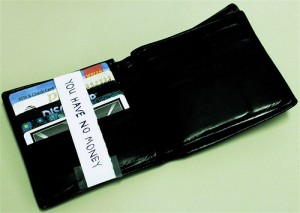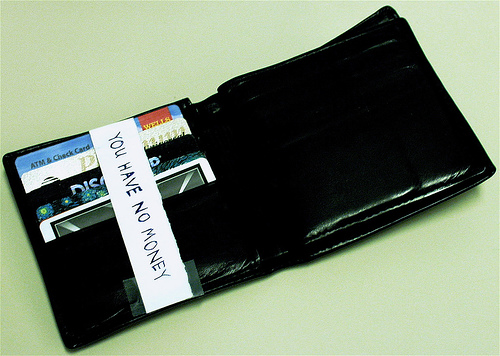- Guide to finding cheap airfare: http://su.pr/2pyOIq #
- As part of my effort to improve every part of my life, I have decided to get back in shape. Twelve years ago, I wor… http://su.pr/6HO81g #
- While jogging with my wife a few days ago, we had a conversation that we haven’t had in years. We discussed ou… http://su.pr/2n9hjj #
- In April, my wife and I decided that debt was done. We have hopefully closed that chapter in our lives. I borrowed… http://su.pr/19j98f #
- Arrrgh! Double-posts irritate me. Especially separated by 6 hours. #
- My problem lies in reconciling my gross habits with my net income. ~Errol Flynn #
- RT: @ScottATaylor: 11 Ways to Protect Yourself from Identity Theft | Business Pundit http://j.mp/5F7UNq #
- They who are of the opinion that Money will do everything, may very well be suspected to do everything for Money. ~George Savile #
- It is an unfortunate human failing that a full pocketbook often groans more loudly than an empty stomach. ~Franklin Delano Roosevelt #
- The real measure of your wealth is how much you'd be worth if you lost all your money. ~Author Unknown #
- The only reason [many] American families don't own an elephant is that they have never been offered an elephant for [a dollar down]~Mad Mag. #
- I'd like to live as a poor man with lots of money. ~Pablo Picasso #
- Waste your money and you're only out of money, but waste your time and you've lost a part of your life. ~Michael Leboeuf #
- We can tell our values by looking at our checkbook stubs. ~Gloria Steinem #
- There are people who have money and people who are rich. ~Coco Chanel #
- It's good to have [things that money can buy], but…[make] sure that you haven't lost the things that money can't buy. ~George Lorimer #
- The only thing that can console one for being poor is extravagance. ~Oscar Wilde #
- Money will buy you a pretty good dog, but it won't buy the wag of his tail. ~Henry Wheeler Shaw #
- I wish I'd said it first, and I don't even know who did: The only problems that money can solve are money problems. ~Mignon McLaughlin #
- Mnemonic tricks. #
- The Wilbur and Orville Wright Papers http://su.pr/4GAc52 #
- Champagne primer: http://su.pr/1elMS9 #
- Bank of Mom and Dad starts in 15 minutes. The only thing worth watching on SoapNet. http://su.pr/29OX7y #
- @prosperousfool That's normal this time of year, all around the country. Tis the season for violence. Sad. in reply to prosperousfool #
- In the old days a man who saved money was a miser; nowadays he's a wonder. ~Author Unknown #
- Empty pockets never held anyone back. Only empty heads and empty hearts can do that. ~Norman Vincent Peale #
- RT @MattJabs: RT @fcn: What do the FTC disclosure rules mean for bloggers? And what constitutes an endorsement? – http://bit.ly/70DLkE #
- Ordinary riches can be stolen; real riches cannot. In your soul are infinitely precious things that cannot be taken from you. ~Oscar Wilde #
- Today's quotes courtesy of the Quote Garden http://su.pr/7LK8aW #
- RT: @ChristianPF: 5 Ways to Show Love to Your Kids Without Spending a Dollar http://bit.ly/6sNaPF #
- FTC tips for buying, giving, and using gift cards. http://su.pr/1Yqu0S #
- .gov insulation primer. Insulation is one of the easiest ways to save money in a house. http://su.pr/9ow4yX #
- @krystalatwork It's primarily just chat and collaborative writing. I'm waiting for someone more innovative than I to make some stellar. in reply to krystalatwork #
- What a worthless tweet that was. How to tie the perfect tie: http://su.pr/1GcTcB #
- @WellHeeledBlog is giving away 5 copies of Get Financially Naked here http://bit.ly/5kRu44 #
- RT: @BSimple: RT @arohan The 3 Most Neglected Aspects of Preparing for Retirement http://su.pr/2qj4dK #
- RT: @bargainr: Unemployment FELL… 10.2% -> 10% http://bit.ly/5iGUdf #
- RT: @moolanomy: How to Break Bad Money Habits http://bit.ly/7sNYvo (via @InvestorGuide) #
- @ChristianPF is giving away a Lifetime Membership to Dave Ramsey’s Financial Peace University! RT to enter to win… http://su.pr/2lEXIT #
- @The_Weakonomist At $1173, it's only lost 2 weeks. I'd call it popped when it drops back under $1k. in reply to The_Weakonomist #
- @mymoneyshrugged It's worse than it looks. Less than 10% of Obama's Cabinet has ever been in the private sector. http://su.pr/93hspJ in reply to mymoneyshrugged #
- RT: @ScottATaylor: 43 Things Actually Said in Job Interviews http://ff.im/-crKxp #
- @ScottATaylor I'm following you and not being followed back. 🙁 in reply to ScottATaylor #
Free Tivo

- Image by Marcin Wichary via Flickr
TV is causing problems in my life.
We watch too much TV. Often, we’re only watching because there’s a crappy show in between two shows we do want to watch. In the winter–during the new seasons–my son has wrestling practice 4 or 5 nights per week, which means I miss the new shows I like. We recently downgraded our service provider, so there’s no functional guide button in the house.
That all makes me sad.
Then I found out that Tivo’s lifetime service is attached to the unit. If you sell a unit with lifetime service, you can transfer the service to the buyer. You can’t, however, transfer the service to a new box. That means that everyone who upgrades and sells their old box is selling the lifetime service with it. If you don’t mind having older equipment, you can pick up a used box with full lifetime service for less than the cost of a new box.
After reading Erica’s method of finding 750 extra hours per year, we decided to give it a shot. We are taking back control of our TV. No more rushing home to catch a new episode. No more mindlessly channel-surfing to kill time between good shows. No more commercials. And a guide! I like having a guide button.
I started shopping. My goal was to get a Series 2 Tivo with full lifetime service for about $100 before shipping. I came close a few times, but always lost the auction, in the end. I wasn’t in a hurry, and I didn’t actually have the money budgeted, so it was good to lose.
Then, a friend found himself in a situation that didn’t work with a Tivo and decided to sell his heavily upgraded, heavily accessorized Tivo HD for $100 + shipping. A quick call to my wife resulted in just one objection: Where were we getting the money? We don’t have an opportunity fund, yet and I needed to take advantage of this quick if we were going to get it.
I decided to make it free.
When I automated all of our bills, I rounded up. If a bill was for $63.50, I paid $64. If a bill wasn’t exactly consistent, I paid enough to cover the higher amount. For example, I didn’t have a text messaging plan on my cell phone until December. Before that, I’d get about a dozen texts each month, so I budgeted for paying for the texts. If I didn’t get the texts, I’d get a credit on my bill. I never lowered the automated payment. All of my bills were set up like that. My insurance company dropped my rates, but I left the payment alone. I slowly started accumulating a credit on a number of bills. My intention was to skip a month when the billed amount got to $0, and apply the money to debt. It was just a mind-game to play with myself to make the debt easier to pay.
I flipped through the bills, looking at the credits. I adjusted the payments to match the bills this month and found more than enough to buy the Tivo. This is a purchase that doesn’t influence my budget in any way. Almost. This unit doesn’t have lifetime service, so I will be paying for the monthly fee, but that’s been more than balanced out by reducing our television service.
This is a recently-high-end model for free, as far as my budget is concerned. I used money that wasn’t even on the table before I went looking for it. It’s like searching the couch cushions for money to catch a movie.
Now, I’ll have control of my TV–with a strong measure of convenience to boot–for $13 per month. The time savings is yet-to-be-determined.
A free Tivo simply because I rounded my bills up when I automated last year. That’s a pain-free opportunity fund.
Update: After I wrote this, I found out that I dropped the ball in budgeting for child-care now that summer is here and my oldest won’t be in school. These costs are going up $350 per month. I spent an hour scavenging the couch cushions of my budget this week. I had to adjust some savings and repayment goals, but I’ve effectively paid for a summer worth of care for my boy the same way. Free.
Investing Basics
If you’ve got your debt paid off, or at least paid down enough to start thinking about using your money for the future instead of the past, it’s time to consider investing your money. If you invest your money, it can grow and start building wealth for you, preferably without your active intervention. Passive income is the best income.
Before you invest in anything, you need to understand the investment completely. In the words of Dave Ramsey, you need to own the investment. There are some questions to ask to get to that level of understanding.
What kind of return can you expect? Will the income come from renters, dividends, or interest? Is the income reliable?
How risky is the investment? Generally, more risk comes with the potential for more income, but that is merely potential. It’s called risk for a reason. If your renters leave, can you make the payments on the property? Will you be financially devastated if the investment tanks? Companies like Standard & Poor’s rate the risk of corporate and municipal bonds.
How liquid is it? How hard will it be to get your money out of the investment? Stocks and bonds can usually be sold at will, but CDs and IRAs almost always come with restrictions. Property requires a seller before you can get your money back out.
Is there a tax advantage? Some investments, like U.S. Savings bonds and municipal bonds, are exempt from varying levels of taxes. Others, such as some IRAs, allow your wealth to grow tax-deferred and can, in some cases, be withdrawn tax-free. Other investments, like a 401k paid out of pre-tax income, can lower your taxable income and actually increase your take-home pay while building your retirement fund. Do you understand the 401k alternatives?
When you are looking at an investment vehicle, make sure it is legitimate. Don’t believe get-rich-quick promises and always back away from high-pressure sales tactics. Always take the time to investigate your investments.
My Financial Life
My financial life right now is boooring.
And that’s a good thing.
When I started this site I was $90,000 in debt, and considering bankruptcy. I’d just started on the Dave Ramsey plan and was looking for every possible way to scrape up any extra money I could.
Now, the debt is nearly gone.

- I’m looking at the last $8000 on my mortgage. I have enough in savings to pay it off today, without draining my savings completely dry.
- My IRA gets maxed out every year, and this year, my wife’s will be, too.
- We save or invest about 30% of our income.
- My credit score according to CreditKarma.com is 826.
Our credit card is almost paid off every month. There’s occasionally some overlap between our auto-payment and our charges. And sometimes the budgeted auto-payment doesn’t match the reality of our spending and I don’t notice for a week or two. Except for the end of last year, but that’s a post for another day.
The short version is: We’re doing well, and we’re nearing the end of our financial problems.
Our scheduled mortgage over-payments will have it completely paid off in October. Then we are debt-free and can hopefully manage to live the rest of our lives without paying interest on money that isn’t earning us more than we are paying. For example, I’m willing to take out a mortgage to buy another rental property, but I’m going to wait to do that until our current mortgage is paid and we have a substantial down payment ready.
No debt.
I’m not kidding when I say it’s been a long 6 years of fighting our debt. Counting a car loan we got and paid early, we’ve paid more than $110,000 of debt in six years.
I’ve run side businesses, aggressively negotiated raises, and left companies(voluntarily and otherwise) for better pay & benefits.
I’ve watched friends and family take vacations around the world.
I’ve turned my kids down for so many things that I would love to buy them, but couldn’t because being financially secure is a much higher priority than spoiling children. Try explaining that to a 6 year old.
And now, the debt-ridden part of our financial journey is almost over. Finally.
So what’s next?
I have no idea. I’d like to travel more. Linda and the girls want us to move to a hobby farm and get horses. We want more rental properties.
Whatever “next” is, it will be done from a position of strength that won’t destroy our financial world or put out futures at risk.
My Financial Plan – How I Improve on Ramsey
In April, my wife and I decided that debt was done. We have hopefully closed that chapter in our lives. I borrowed, then purchased, The Total Money Makeover by Dave Ramsey.  budget” width=”300″ height=”213″ />We are almost following his baby steps. Our credit has always been spectacular, but we used it a lot. Our financial plan is Dave Ramsey’s The Total Money Makeover, with some adjustments.
budget” width=”300″ height=”213″ />We are almost following his baby steps. Our credit has always been spectacular, but we used it a lot. Our financial plan is Dave Ramsey’s The Total Money Makeover, with some adjustments.
Step 1. Budget:
The budget was painful, and for the first couple of months, impossible. We had no idea what bills were coming due. There were quarterly payments for the garbage bill and annual payments for the auto club. It was all a surprise. Surprises are setbacks in a budget.
When something came up, we’d start budgeting for it, but stuff kept coming up. We’re not on top of all of it, yet, but we are so much closer. We’ve got a virtual envelope system for groceries, auto maintenance, baby needs(we have two in diapers) and some discretionary money. We set aside money for everything that isn’t a monthly expense, and have a line item for everything that is. My wife is eligible for overtime and monthly bonuses. That money does not get budgeted. It’s all extra and goes straight on to debt, or to play catch-up with the bills we had previously missed. I figure it will take a full year to get all of the non-monthly expenses in the budget and caught up.
Step 2. The initial emergency fund:
Ramsey recommends $1000, adjusted for your situation. I decided $1000 wasn’t enough. That isn’t even a month’s worth of expenses. We settled on $1800, plus $25/month. It’s still not enough, but it’s better. Hopefully, we’ll be able to ignore it long enough that the $25/month accrues to something worthwhile.
Step 3. The Debt Snowball:
This is the controversial bad math. Pay off the lowest balance accounts first, then take those payments and apply them to the higher balance accounts. Emotionally, it’s been wonderful. We paid off the first credit card in a couple of weeks, followed 6 weeks later by my student loan. Since April, we’ve dropped nearly $10,000 and we haven’t made huge cuts to our standard of living. At least monthly, we re-examine our expenses to see what else can be cut.
Step 4. Three to six months of expenses in savings:
We aren’t on this step yet. In step 2, we are consistently depositing more, making us more secure every month.
Step 5. Invest 15% of household income into Roth IRAs and pre-tax retirement:
I have not stopped my auto-deposited contribution. It’s stupid to pass up an employer match. My wife’s company does not match, so she is currently not contributing.
Step 6. College funding for children:
We have started a $10 College fund.
Step 7. Pay off home early:
I don’t see the point in handling this one separately. Our mortgage is debt, and when the other debts are paid, we will be less than a year from owning our house, free and clear. This is rolled in with step three. All debt is going away, immediately.
Step 8. Build wealth and give!
We have cut off most of our charitable giving. Every other year, it has been a significant percent of our income, and in a few more years, will be so again. The only exception to this is children knocking on the door for fundraisers. I have no problems with saying no to a parent fundraising for their kid, but when the kids is doing the work, door-to-door, especially in the winter, I buy something. My son’s school, on the other hand, gets fundraisers ignored. When they come home, I send a check to the school, ignoring the program. I bypass the overhead and make a direct donation.
What Is Your Binary Options Strategy?
 When you are just entering the world of binary options trading or investing, you may be on the receiving end of a lot of advice. It is not uncommon to hear people tell you to implement different gambling strategies because binary options are based on chance more than anything else. You will also hear a lot of advice from those who say there are many good ways to develop an effective strategy using indicators and market signals. Some will insist that with proper analysis of market data, a solid strategy can be developed too.
When you are just entering the world of binary options trading or investing, you may be on the receiving end of a lot of advice. It is not uncommon to hear people tell you to implement different gambling strategies because binary options are based on chance more than anything else. You will also hear a lot of advice from those who say there are many good ways to develop an effective strategy using indicators and market signals. Some will insist that with proper analysis of market data, a solid strategy can be developed too.
Are they all correct? Interestingly enough, the answer is yes. The reason for this is simple, and as one expert writes, “there is no such thing as a perfect strategy for every trader. There is only a best strategy for each individual trader.” Thus, your strategy has to be shaped around a few things:
- Your willingness and ability to follow your chosen strategy.
- Your personality. For instance, are you restless if you are taking the safe route or a higher risk strategy?
- Your budget and goals,
Identifying the answers to these questions is the first step to formulating a strategy. You should also understand that the winning percentage of most strategies will be somewhat constant, but the total number of successful trades varies on an individual basis and is based entirely on the strategies used.
For instance, some investors want a high percentage of winning trades and are more comfortable with risk averse trading. Others are ready to take more risk and are entirely comfortable winning fewer trades if the returns on winning trades are dramatically higher. This enables them to implement higher risk trades. The interesting thing about strategies and the kinds of trades they generate is that they are all built from the same data.
The Data of Strategy
For example, almost all strategies will look at issues like market trends, trading trends, highs and lows, reversals, and various kinds of indicators. The reason that high and low trends pay off in strategy development is simple: binary options trading applies to whether or not an asset rises above a strike price or doesn’t. It is the proverbial “yes or no” part of the proposition and analysis for either outcome pays off.
As an example, a lot of risk-averse investors will look for breakouts. They use these for trend line investing, which can be as brief as sixty seconds to a day, but can be used to coordinate investing in the direction of a short trend. Although this seems complex, it really is not. The key is that analysis cannot be broad and across all available markets. Instead, focused analysis on a specific area will allow even a novice investor to analyze for a breakout and then invest in binary options accordingly.
Just being able to detect a reversal or a downward trend over the course of a day can yield a very rewarding investment. The key is to understand your strategy based on your budget, personality, and your ability to stick with the strategy, even if it does not yield immediate success. When you do this, and use the right tools for analysis, you can create an effective strategy that brings you closer to your goals.
This is a guest post.

